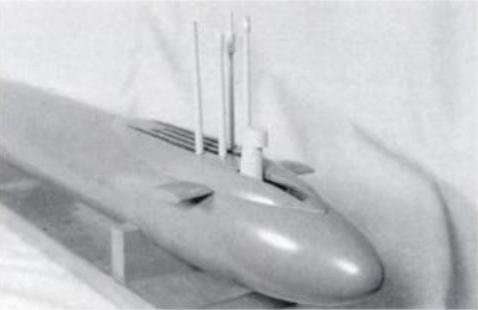Images of a model from the US Navy concept formulation (CONFORM) submarine project from the late 1960s. CONFORM was a possible follow-on to the Permit (SSN 594) and Sturgeon (SSN 637) classes devised by Naval Sea Systems Command (NavSea) circa 1967-68. By November 1968, the initial CONFORM studies had produced 36 design concepts, examining such alternative features as twin reactors, single turbines, contra-rotating propellers, deep-depth capability, and larger diameter torpedo tubes.
One CONFORM concept was to use a derivative of the S5G Natural Circulation Reactor (NCR) plant that Vice Admiral Hyman G Rickover was developing for the one-of-a-kind Narwhal (SSN 671). The NCR uses the natural convection of the heat exchange fluids (coolants) at lower speeds rather than circulating pumps, a major noise source of propulsion machinery in nuclear submarines.
The S5G was estimated to be capable of providing a submerged speed of more than 30 knots with a CONFORM submarine hull approximately the same size as Sturgeon, about 4,800 tons submerged. 20,000 shaft horsepower would power a counter-rotating propeller.
One of the most innovative features of the pictured CONFORM design was its periscopes and masts that folded down flush onto the hull rather than retracting vertically into the hull. This feature would have reduced pressure hull penetrations, provided more flexibility in internal arrangement, and possibly alleviated the need for a sail. A small bridge structure could be raised and then folded down flush onto the hull.
The "front end" of the CONFORM was to be greatly improved, with an increased number of weapons, advanced sonar, and a high degree of automation.
According to Polmar, the CONFORM project was "scuttled" by Vice Admiral Hyman G Rickover in favor of the Los Angeles class.
Source: Cold War Submarines: the Design and Construction of U.S. and Soviet Submarines
by Norman Polmar and Kenneth J. Moore, Brassy's, Inc., 2004.
One CONFORM concept was to use a derivative of the S5G Natural Circulation Reactor (NCR) plant that Vice Admiral Hyman G Rickover was developing for the one-of-a-kind Narwhal (SSN 671). The NCR uses the natural convection of the heat exchange fluids (coolants) at lower speeds rather than circulating pumps, a major noise source of propulsion machinery in nuclear submarines.
The S5G was estimated to be capable of providing a submerged speed of more than 30 knots with a CONFORM submarine hull approximately the same size as Sturgeon, about 4,800 tons submerged. 20,000 shaft horsepower would power a counter-rotating propeller.
One of the most innovative features of the pictured CONFORM design was its periscopes and masts that folded down flush onto the hull rather than retracting vertically into the hull. This feature would have reduced pressure hull penetrations, provided more flexibility in internal arrangement, and possibly alleviated the need for a sail. A small bridge structure could be raised and then folded down flush onto the hull.
The "front end" of the CONFORM was to be greatly improved, with an increased number of weapons, advanced sonar, and a high degree of automation.
According to Polmar, the CONFORM project was "scuttled" by Vice Admiral Hyman G Rickover in favor of the Los Angeles class.
Source: Cold War Submarines: the Design and Construction of U.S. and Soviet Submarines
by Norman Polmar and Kenneth J. Moore, Brassy's, Inc., 2004.


